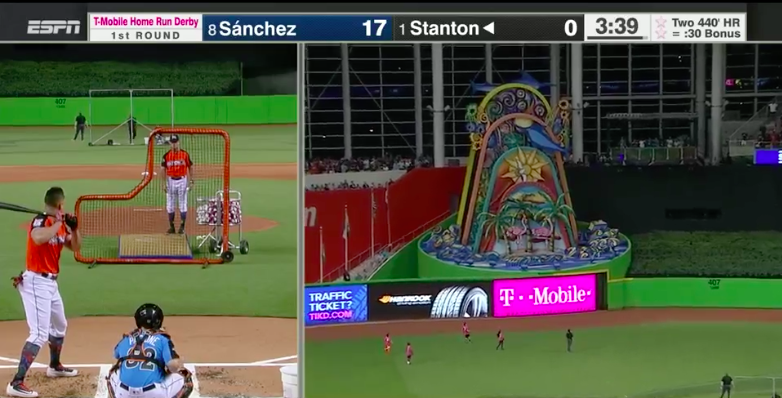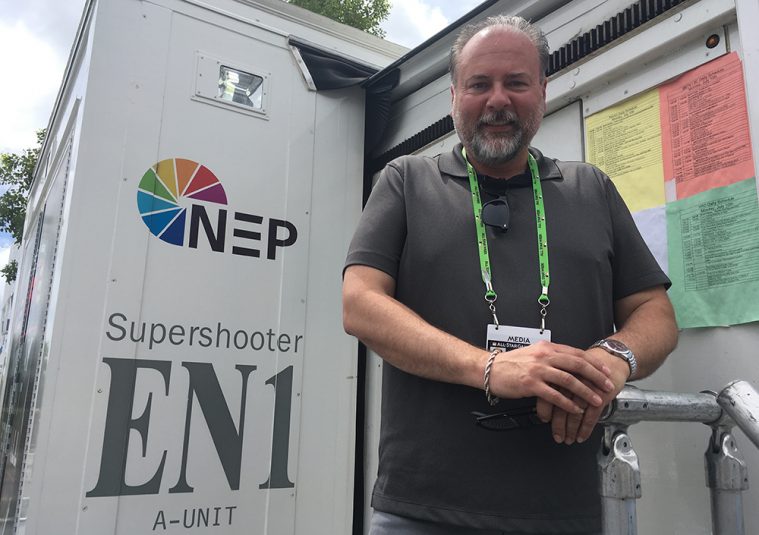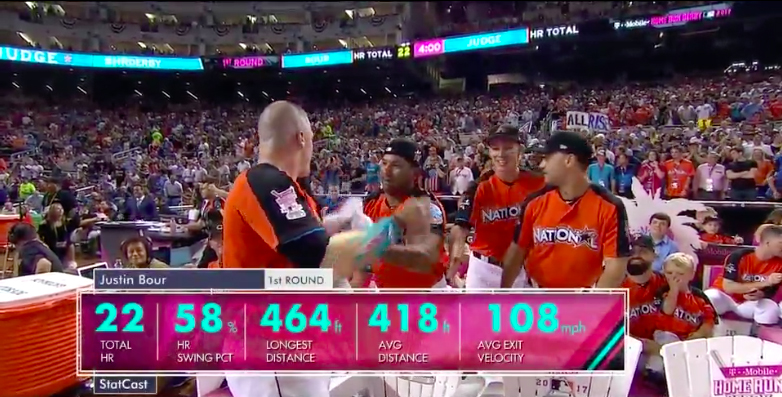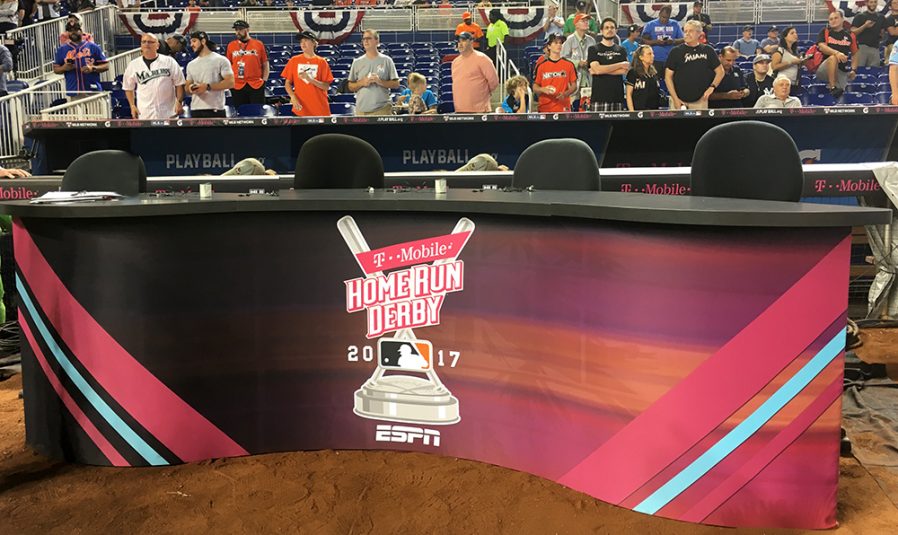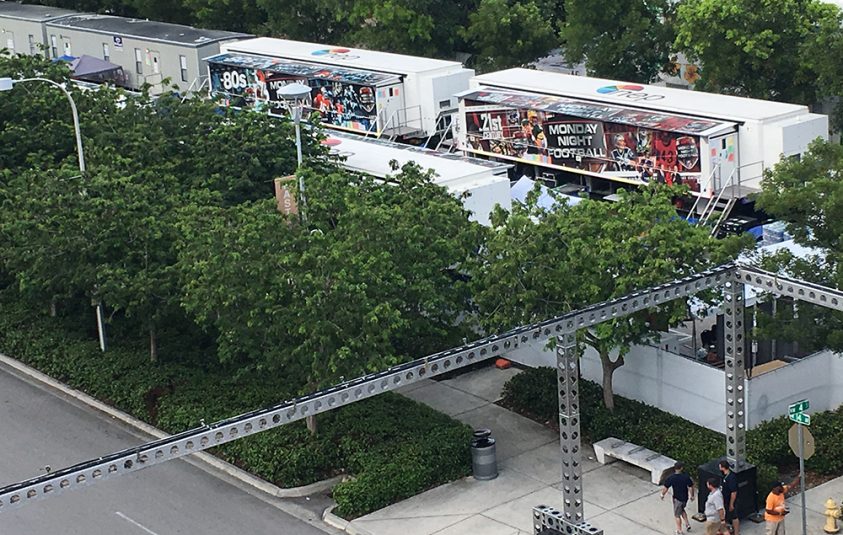Live From MLB All-Star: Split-Screen Format Helps ESPN Keep Up With Fast-Paced Home Run Derby
More than 30 cameras, buried mics around home plate are also deployed
Story Highlights
As the format of the annual MLB Home Run Derby has changed dramatically in recent years, so too has ESPN’s coverage of the homerfest — a fact that was never more apparent than in last night’s Derby telecast from Marlins Park in Miami. To keep up with the ultra-rapid hit-as-many-homers-as-possible-in-four-minutes format, ESPN deployed a split screen for the first time in its coverage and also used a “two-box” format for commercial breaks between rounds, allowing viewers to continue to watch the action in one box while a 30-second spot played on the other.
“Refreshing the format and increasing the pace has driven the production philosophy, and we’ve had to respond,” said Phil Orlins, senior coordinating producer for MLB, ESPN, on Monday prior to the Derby. “Obviously, our speed needed to improve, and I think we have been able to do that. So our coverage philosophy has changed pretty dramatically.”
Split-Screen Rounds and Two-Box Commercials
In the split-screen format, two-thirds of the 16×9 frame featured a right-hand box offering a traditional switched feed, with director Doug Homes calling cameras to cover the batter, flight of the ball, other players on the field, and so on. The left-side box featured a stable batter/pitcher shot (from either centerfield or the robo behind home plate).
“Obviously, this was largely driven by the fact that the pitches are coming just as the balls land or just before. And we don’t want [viewers] missing a single swing,” said Orlins. “Last year, we simplified things by instituting side-by-side high-home [camera positions] and rotating back and forth. This year, we add the side-by-side coverage to go with the side-by-side high-home [positions]. It’s a pretty dramatic evolution of the coverage, but I think it makes for a better product.”
Each time, a hitter took his optional 30-second timeout, ESPN cut to a two-box format, with the left two-thirds of the screen showing the 30-second commercial spot and the right third showing a live feed of the Derby, along with a 30-second countdown clock and the player’s home-run total at that point. The strategy allowed ESPN to show the first four batters’ rounds in their entirety without having to break away from the telecast for a commercial, accounting for more than 30 minutes of live Derby action.
“It’s going to allow us to streamline the rest of the format a little bit and really focus on the Derby itself,” said Orlins. “We think this is a huge benefit for the fans, as well as from a ratings standpoint.”
Plenty of On-Field Firepower for the Derby
ESPN deployed more than 30 cameras for its Home Run Derby coverage, including three wireless RF cameras (one a Steadicam) provided by CP Communications, two ultra-slo-mo systems (on the first- and third-base sides), a Phantom cam at low-first, five Fletcher robos (two directly in front of home plate, high-home, mid-home, and on the left-field foul pole), four Marshall POVs, and the Goodyear Blimp for aerial shots.
On the audio side, ESPN buried four Quantum 5X in-ground mics around home plate to capture on-field audio — a tactic the network has begun using on Sunday Night Baseball.
“We introduced the field mics on [Sunday Night Baseball] this year, and they have really enhanced the audio coverage,” said Paul Horrell, remote operations manager, ESPN. “Obviously, that only becomes more important for the Derby because you want to get that monster crack of the bat on every home run.”
Statcast Takes on Bigger Role at Derby
MLB Advanced Media’s Statcast has become an integral part of ESPN’s Derby coverage over the past two years, and that trend continued last night.
The system provided real-time home-run distances and exit velocity on every homer, allowing ESPN to display a graphic at the end of each round featuring total HRs, HR Swing Pct., Longest Distance, Average Distance, and Average Exit Velocity.
“Each year, we are [relying] more and more on the Statcast operation on all the data they can provide us,” said Orlins. “We’ve gotten pretty aggressive with it, and I think that will only continue.”
Much More Than Just the Mothership: EN1 Serves Several Entities
ESPN increased its already sizable All-Star onsite presence for this year’s edition in Miami. In addition to its primary set on the third-base line, ESPN Deportes has an on-field set of its own this year on the first-base line with Beisbol Esta Noche, as does ESPN2’s Nación ESPN (In addition, the Spanish-language feed of this year’s Derby was simulcast on ESPN2 for the first time).
ESPN’s studio programming onsite on Monday also included two editions of Baseball Tonight, a simulcast of MLB Network’s Intentional Talk, and SportsCenter on the Road.
In addition, ESPN once again produced the All-Star Legends & Celebrity Softball Game live to tape for its Monday-night broadcast.
Inside the truck compound across the street from the ballpark, NEP’s EN1 fleet of mobile units (A, B, C, D, and E) served as the hub of ESPN’s Home Run Derby production and onsite studio programming. The A unit produced the Derby show, and the B unit handled studio programming (just as they do when EN1 handles Monday Night Football in the fall).
“We have so many different production entities here, but we really wanted satisfy all of the [them] out of EN1,” said Horrell. “So, coming into this year, we wanted to look at the workflow and see how we could simplify it as much as possible. We are trying to share cameras, space in the truck, and all our other assets across all the different production entities onsite. As you can imagine, that requires an enormous amount of logistics and coordination, but we have a great [operations] team on it this year and everything has gone great.
“We are blessed to have one of the most knowledgeable and capable teams I’ve ever worked with,” he added. “It’s a monster of an event, so you have to dedicate people that you can trust. And we were lucky to have Joa [O’Connor, senior operations producer] and Kevin [Cleary, remote production operations specialist], heading up the project from early on.”
On the transmission side, the Home Run Derby was fed to Bristol, CT, via fiber over The Switch’s network, but ESPN opted to forego a satellite backup this year. Instead, AT&T provided a redundant fiber path, while The Switch provided a third-tier backup via IP delivery.
